CONCEPTUAL PROJECTS
A Temporary Outpost of the Blue Fashion Commons
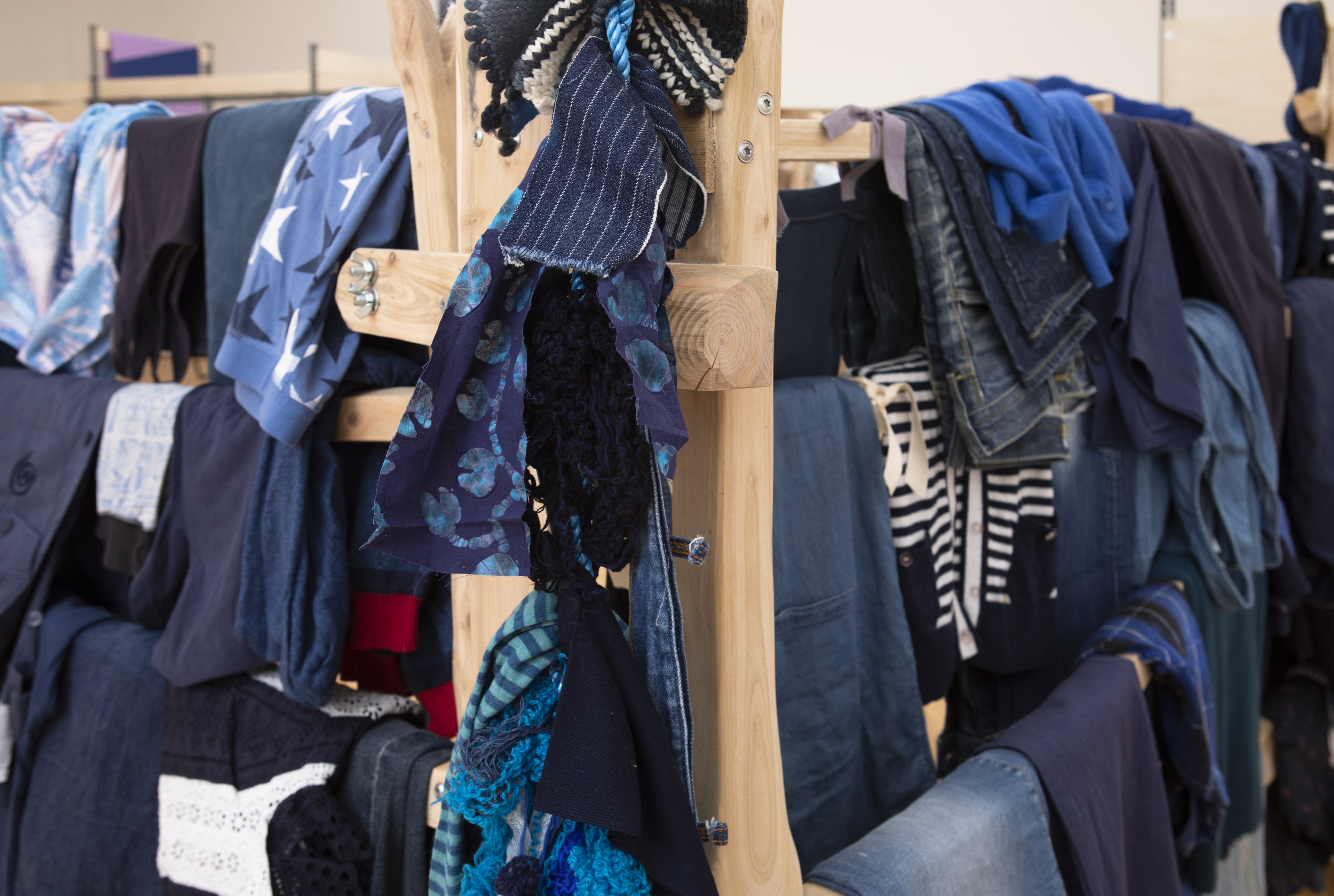
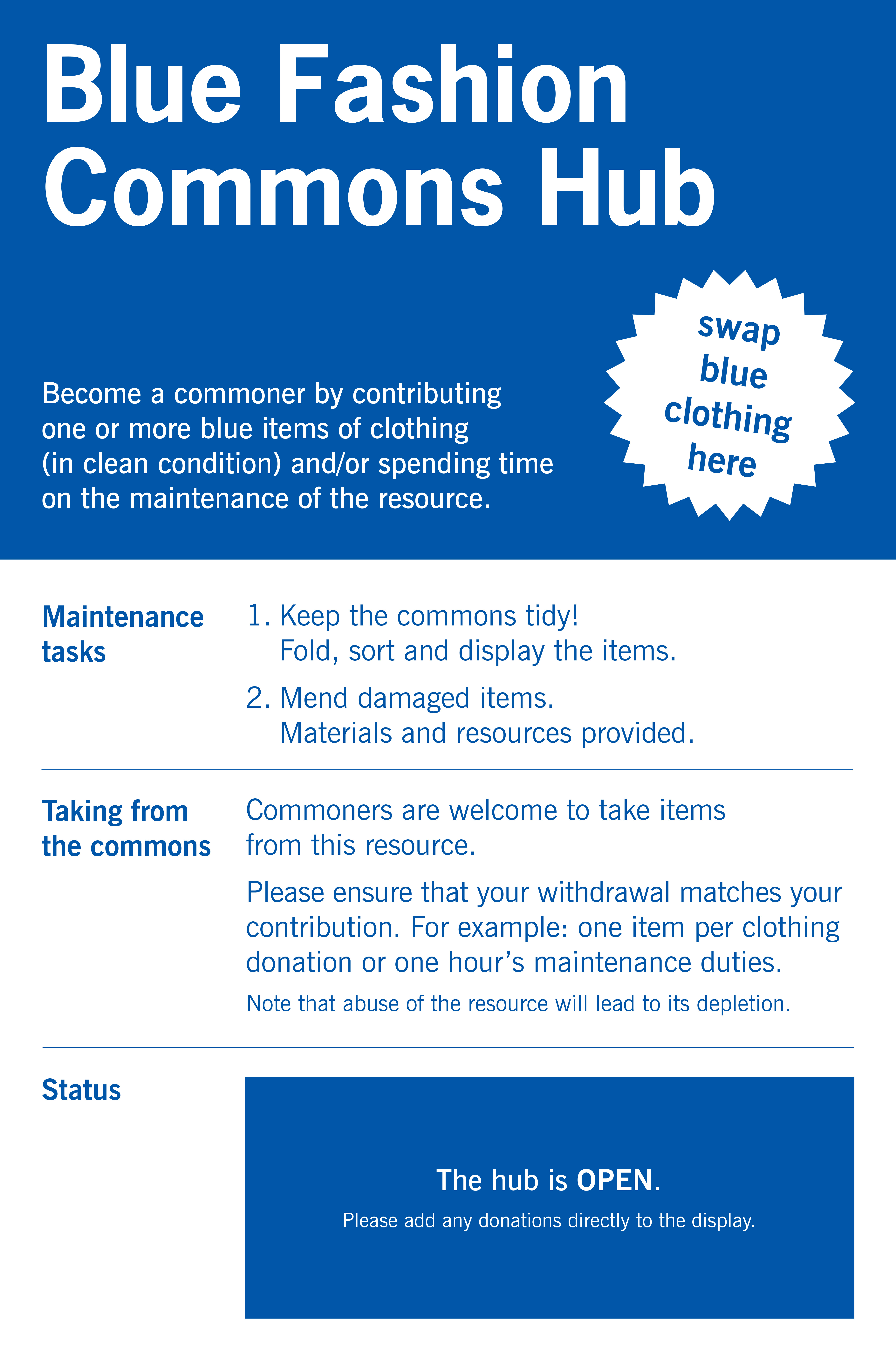

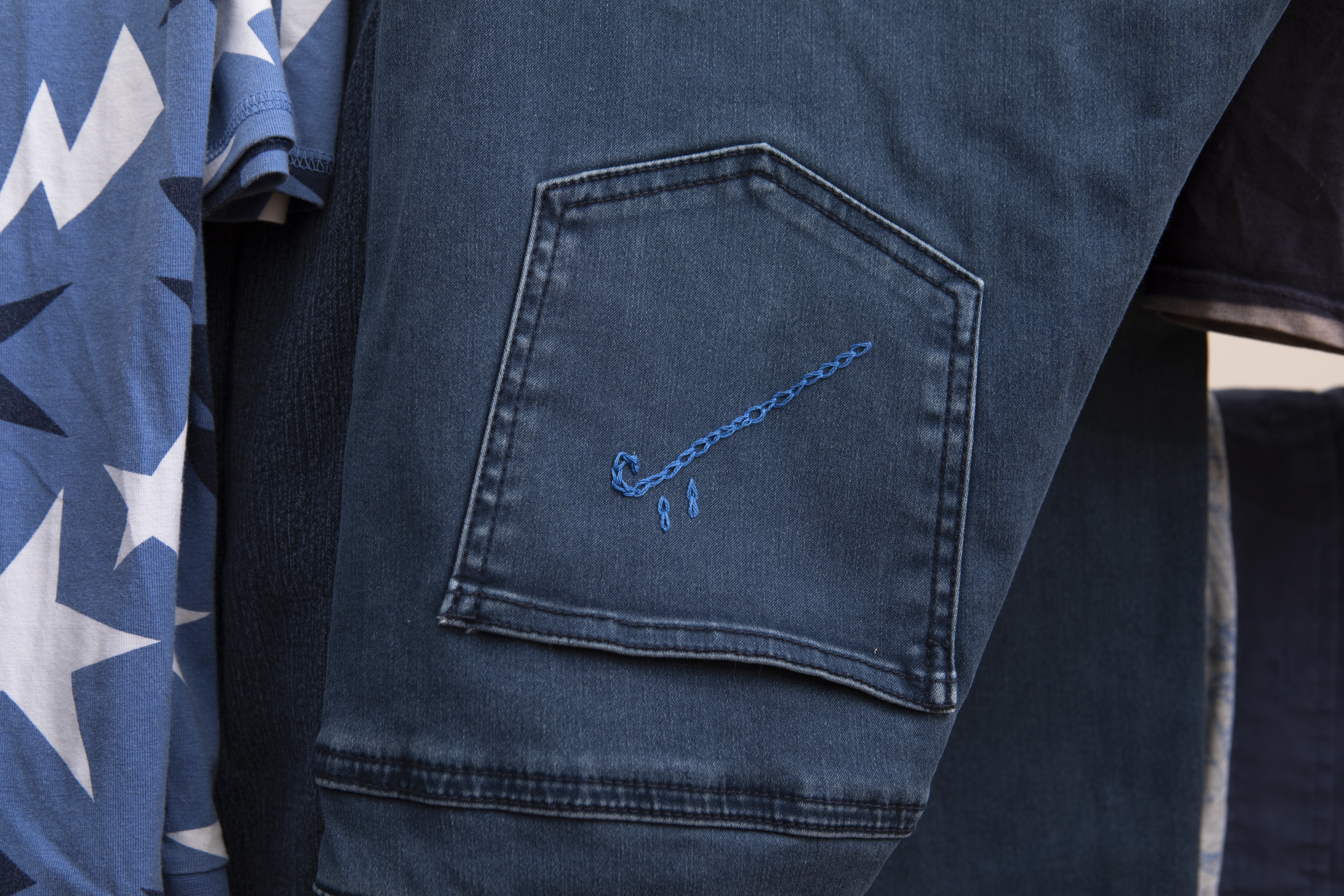

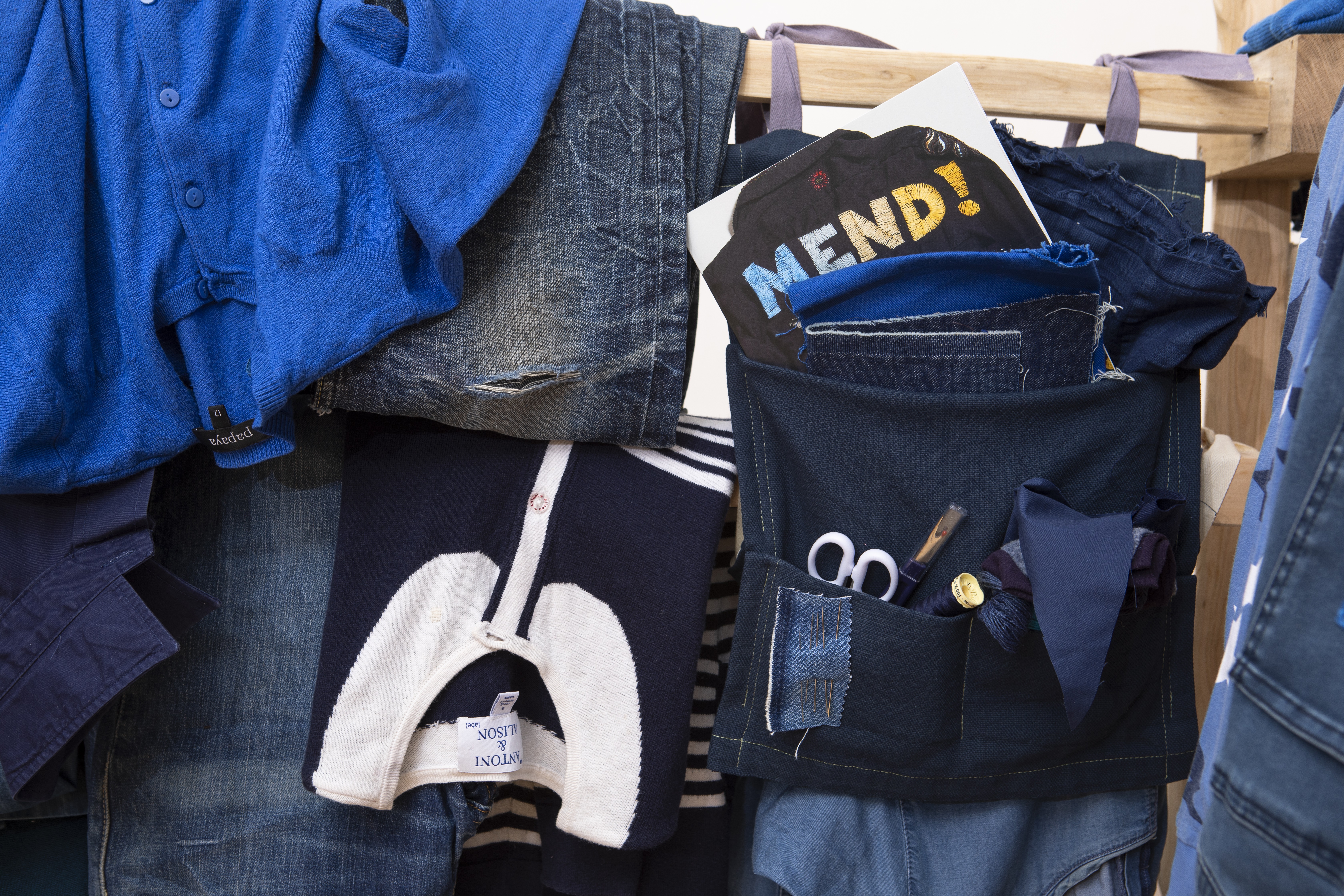
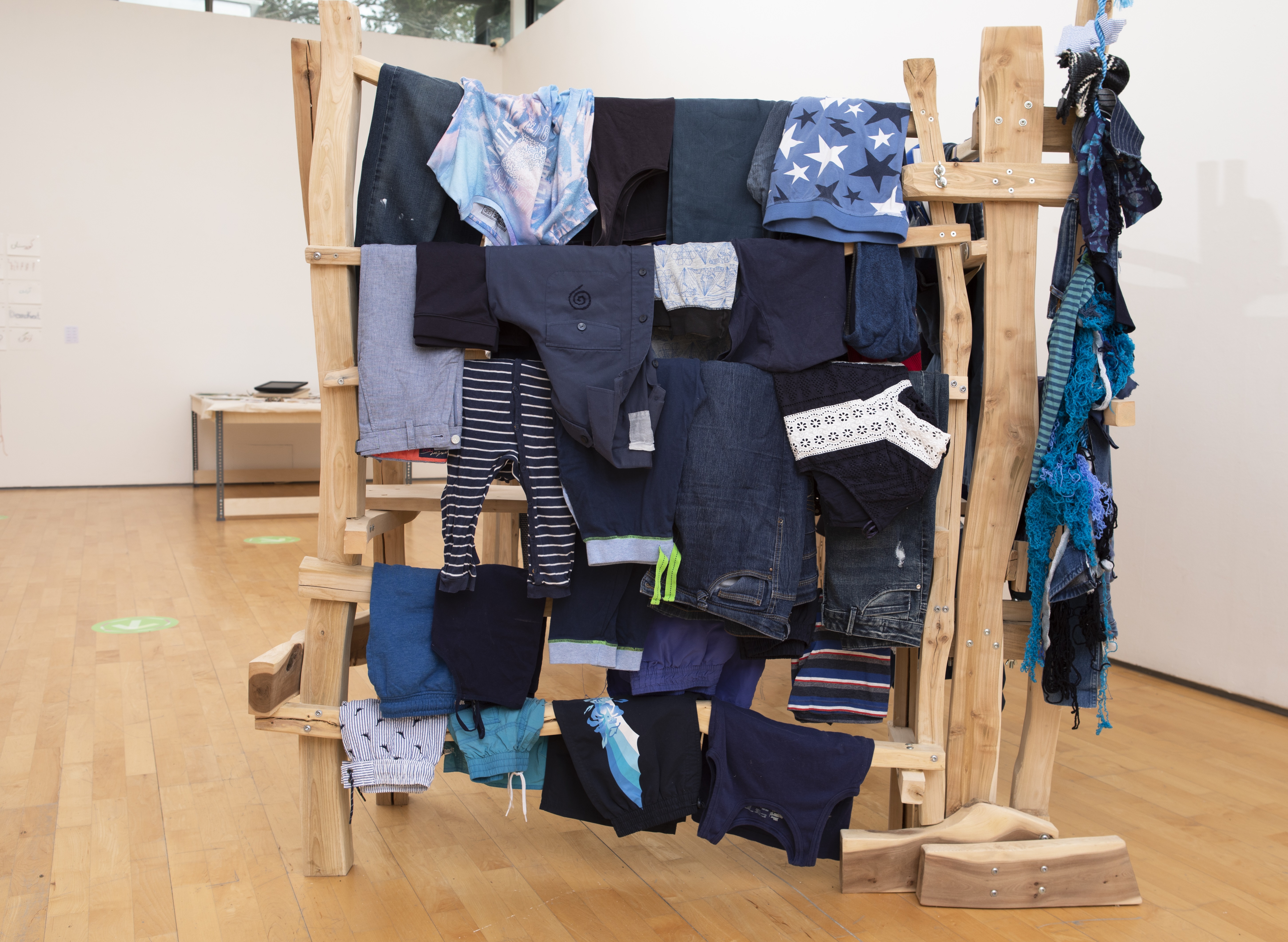

images 1, 5, 6, 7, 8, 10 and 11 courtesy of Craftspace/Dewi Tannatt Lloyd
‘A Temporary Outpost of the Blue Fashion Commons’ is an interactive installation that explores the notion of clothing as a shared community resource, rather than as privately owned outputs of a hyper-commercial system. The work is presented as a window into a fictional parallel world, where – for environmental reasons – the sale of all blue textiles, whether new or used, has been banned. With the supply of new items cut off, systems of exchange have developed in which blue items are traded and repaired at community-run hubs.
The hub presented in the exhibition takes the form of a bespoke wooden structure, created by fellow exhibitor Ben Coode-Adams of Blackwater Polytechnic. The structure is used to display a varied assortment of everyday blue garments and accessories for adults and children, along with resources to support their repair. Where public health guidelines allow, exhibition visitors will be invited to use the hub as they would in the parallel world. While a visitor may take a garment away without any monetary payment, they must do so according to the hub’s rules. These rules specify that people must donate garments, skills or time to earn the right to withdraw items.
Will people participate according to the rules of this miniature commons and thus enable the installation to become a successful unmanned clothes swap? Or will it descend into an untidy mess, picked clean of its most desirable items? The uncertain outcome of this experiment demonstrates the contingent nature of every commons, and the ongoing work that is required for a commons to thrive over time. The installation also encourages us to think differently about our clothing – as items that can be borrowed, again and again, from a vast shared material resource, rather than as products designed for rapid disposal – and prompts us to reflect on the crucial role of maintenance in situations where material resources are limited.
Visitors who take the time to study the garments displayed within the installation may notice items embellished with distinctive chain-stitch motifs. This trend has arisen within the parallel world, where many have rejected branded logos and meaningless imagery and instead started to embroider their items with folk symbols. Motifs taken from nineteenth-century English smocks, a rich yet little-celebrated craft tradition, are particularly popular. An instructable that I have created to accompany the work supports people to embroider a blue item from their own wardrobe in this style.
‘A Temporary Outpost of the Blue Fashion Commons’ is linked to my international research initiative, Fashion Fictions, which brings people together to generate, experience and reflect on engaging fictional visions of alternative fashion cultures and systems. The project gathers short written outlines of fictional sustainable fashion worlds via an open call; the outlines are then developed through participatory collaborative workshops into visual and material prototypes and living ‘everyday dress’ projects, such as this installation.
Stitch-hacking
My 'stitch-hacking' technique allows me to tinker with found knitted garments, laddering and re-forming the stitches and exploring ideas of ownership and authorship.
Several of these pieces were included in the Units of Possibility exhibition, part of the Reknit Revolution project.
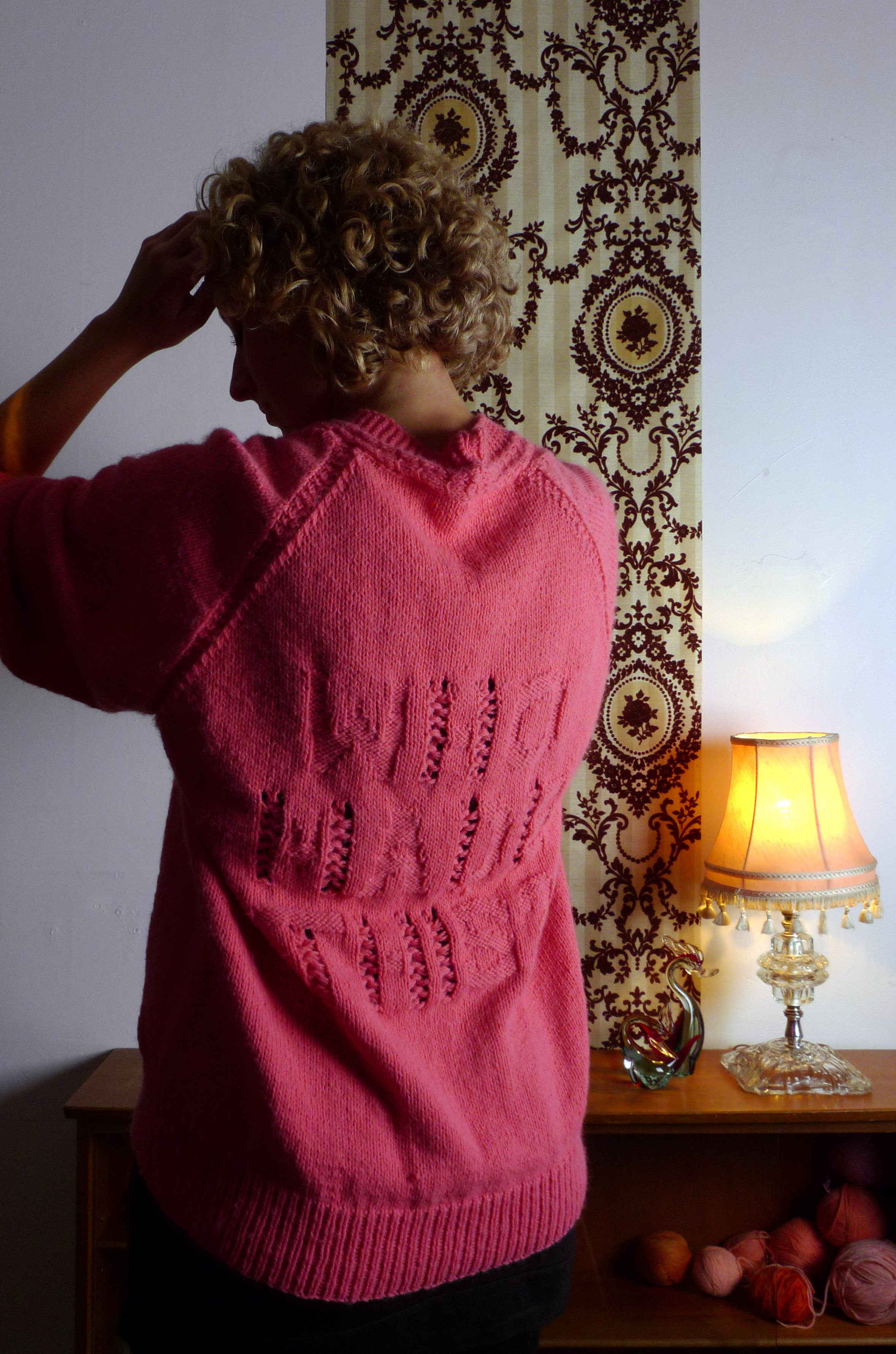
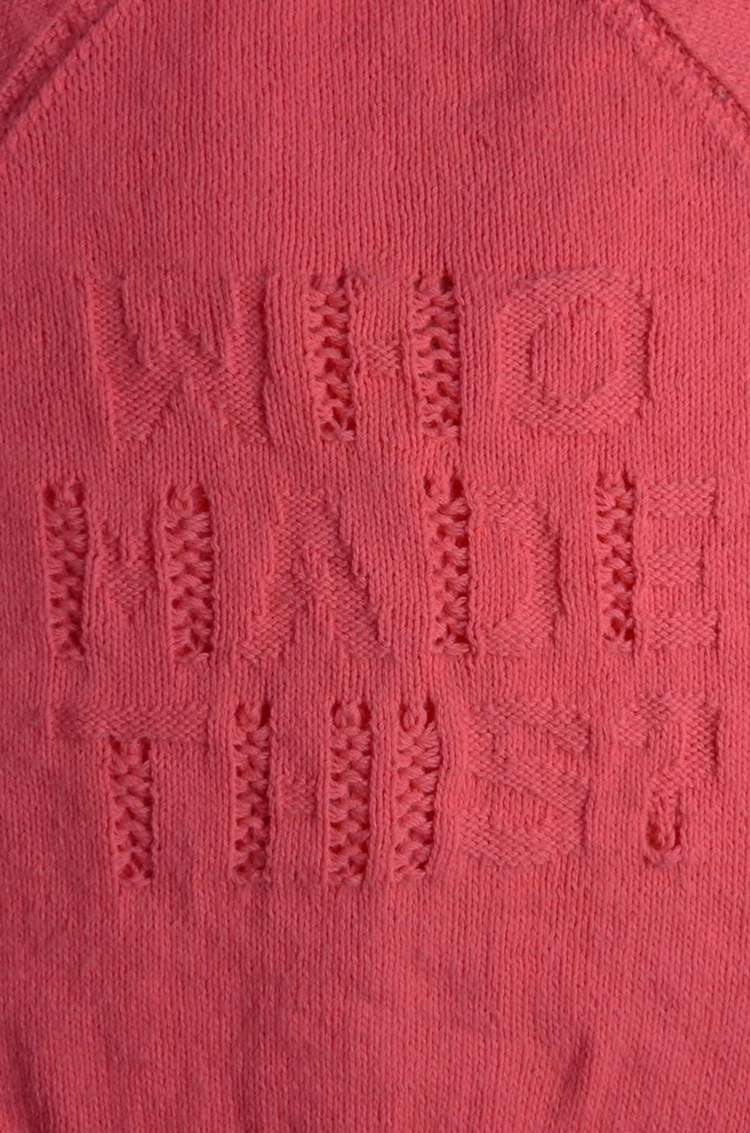
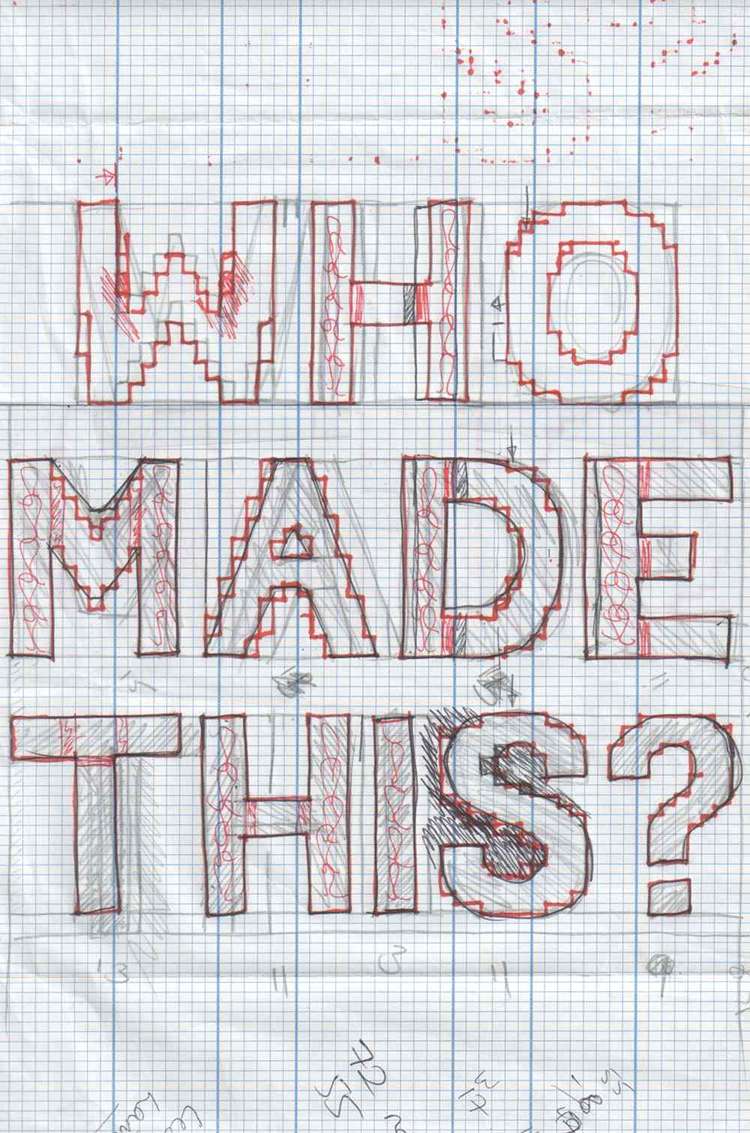
Who Made This?
Found cardigan, stitch-hacked
This cardigan was the first stitch-hacked piece I made, and has particular personal significance. The original cardigan was found in my late great-aunt's house, in a chest of drawers full of hand-knitted cardigans. We think it was knitted by my grandmother Gladys, but can't be sure.
Who made this cardigan? The original knitter made the stitches, but I laddered and re-formed them.
Found cardigan, stitch-hacked
This cardigan was the first stitch-hacked piece I made, and has particular personal significance. The original cardigan was found in my late great-aunt's house, in a chest of drawers full of hand-knitted cardigans. We think it was knitted by my grandmother Gladys, but can't be sure.
Who made this cardigan? The original knitter made the stitches, but I laddered and re-formed them.
St Michael - 12 - 40
Found cardigan, stitch-hacked
All of the information hacked into this cardigan was taken from the labels inside the garment. The text includes the St Michael logo, its country of manufacture, the garment size, colour and two code numbers.
My hacking intervention celebrates, and painstakingly brings to the surface, traces of the garment's story. It makes me wonder: who made this piece, and when? How many were made? The questions, along with the act of physical intervention, create a strong connection with this otherwise unremarkable cardigan.
![]()
![]()
14GB
Found vest, stitch-hacked
After creating 'St Michael - 12 - 40' I was keen to continue the St Michael theme. This little vest (sourced after extensive eBay searching) is older, and even finer gauge, than the first piece.
Again, the text is lifted directly from the garment label: size, country of origin and retailer's code. The purl stitches forming the circle around '14GB' are double-gauge: I ladder two columns of stitches and reform them as one, splitting back to their original size for the smooth surfaces of the numbers and letters.
![]()
![]()
![]()
Amy 2010
Found cardigan, stitch-hacked
I acquired this cardigan at some point in the last few years, at a charity shop or perhaps a jumble sale. It languished, unnoticed, in my wardrobe for some time before I heard its call to be hacked.
The fairisle fabric presented a tough hacking challenge: I had to plan out my personalised design using the same number of white and blue stitches on each row as the original.
![]()
![]()
![]()
S - H&M
Found jumper, stitch-hacked
In 2012, I was commissioned to create a stitch-hacked piece for the Crafts Council's Handling Collection. For the commission, I was keen to source a mass-produced item of knitwear from a brand which would be instantly recognisable to people of all ages. After a long charity shop search, I found the ideal candidate: an H&M jumper with size and country of manufacture on the back neck label. These elements formed the design that I eventually hacked into the ultra-fine stitches.
By 'surfacing' information about the garment's manufacture I hope to highlight the origins of the garments that fill our wardrobes, and consider the skill and status of those who work in garment factories overseas. Because we are given limited information by the retailer, we can only imagine the conditions in which this item was made.
Along with the garment, I supplied a chunky gauge sample showing a step-by-step version of the stitch-hacking technique, a stitch-hacking latch tool, the original charts for the design, and images of the work in progress.
![]()
![]()
![]()
![]()
![]()
![]()
ATH + Jayfor
Found jumper, stitch-hacked and swiss darned
I took the text from the label of this old jumper - 'Jayfor of Auchtermuchty', 'made in Scotland' - and transposed it to the body of the garment, 'embossing' it into the structure of the plain knitting.
After the hacking, I used swiss darning (which embellishes, rather than restructures, the fabric) to record my part in its transformation. I added 'ATH +' to the Jayfor text, and '+ England' to 'made in Scotland'.
I love the font and placement of the Jayfor logo, which creates an incongruous reference to the Pink Ladies of Grease.
Found cardigan, stitch-hacked
All of the information hacked into this cardigan was taken from the labels inside the garment. The text includes the St Michael logo, its country of manufacture, the garment size, colour and two code numbers.
My hacking intervention celebrates, and painstakingly brings to the surface, traces of the garment's story. It makes me wonder: who made this piece, and when? How many were made? The questions, along with the act of physical intervention, create a strong connection with this otherwise unremarkable cardigan.


14GB
Found vest, stitch-hacked
After creating 'St Michael - 12 - 40' I was keen to continue the St Michael theme. This little vest (sourced after extensive eBay searching) is older, and even finer gauge, than the first piece.
Again, the text is lifted directly from the garment label: size, country of origin and retailer's code. The purl stitches forming the circle around '14GB' are double-gauge: I ladder two columns of stitches and reform them as one, splitting back to their original size for the smooth surfaces of the numbers and letters.

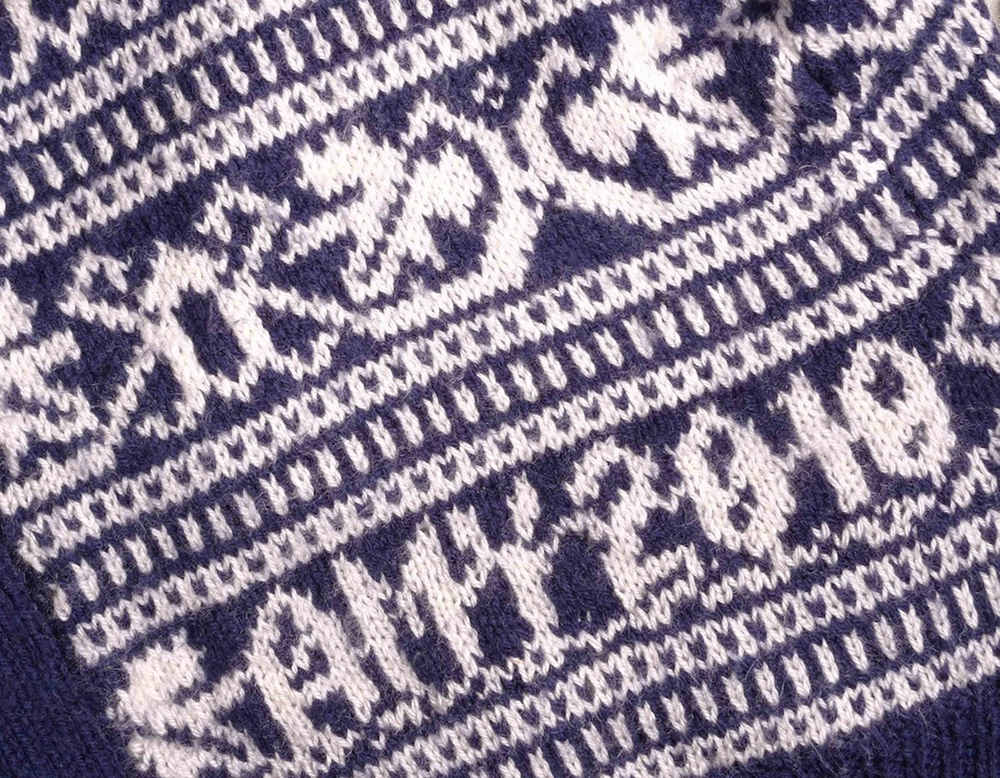
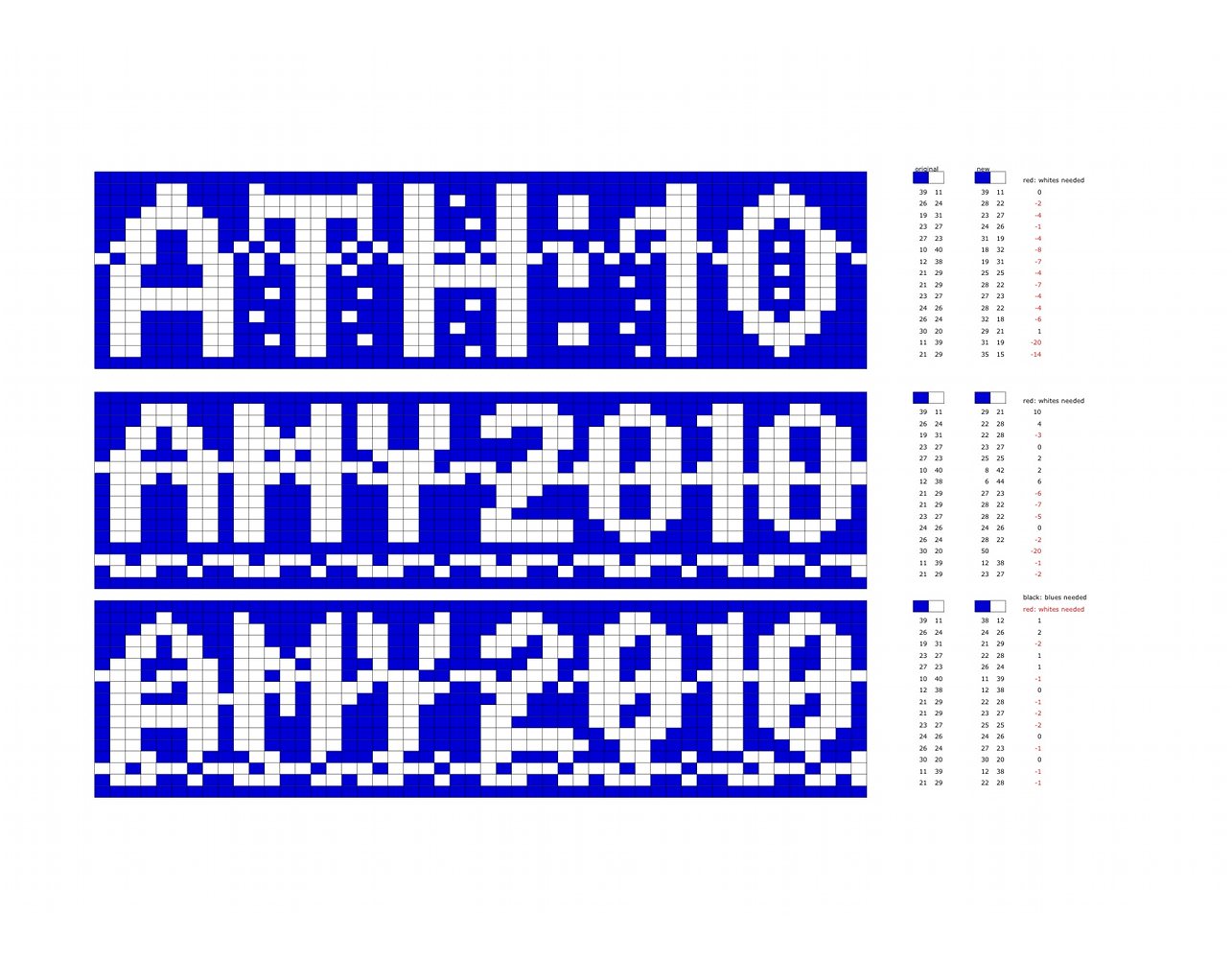
Amy 2010
Found cardigan, stitch-hacked
I acquired this cardigan at some point in the last few years, at a charity shop or perhaps a jumble sale. It languished, unnoticed, in my wardrobe for some time before I heard its call to be hacked.
The fairisle fabric presented a tough hacking challenge: I had to plan out my personalised design using the same number of white and blue stitches on each row as the original.
S - H&M
Found jumper, stitch-hacked
In 2012, I was commissioned to create a stitch-hacked piece for the Crafts Council's Handling Collection. For the commission, I was keen to source a mass-produced item of knitwear from a brand which would be instantly recognisable to people of all ages. After a long charity shop search, I found the ideal candidate: an H&M jumper with size and country of manufacture on the back neck label. These elements formed the design that I eventually hacked into the ultra-fine stitches.
By 'surfacing' information about the garment's manufacture I hope to highlight the origins of the garments that fill our wardrobes, and consider the skill and status of those who work in garment factories overseas. Because we are given limited information by the retailer, we can only imagine the conditions in which this item was made.
Along with the garment, I supplied a chunky gauge sample showing a step-by-step version of the stitch-hacking technique, a stitch-hacking latch tool, the original charts for the design, and images of the work in progress.



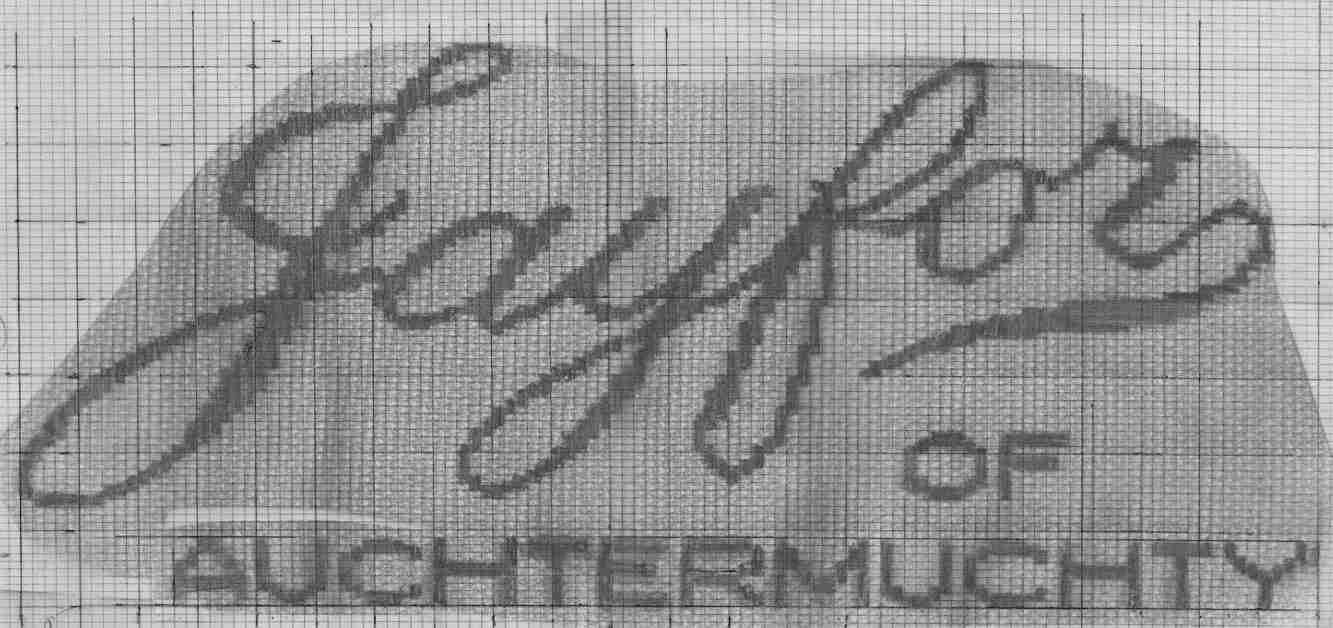
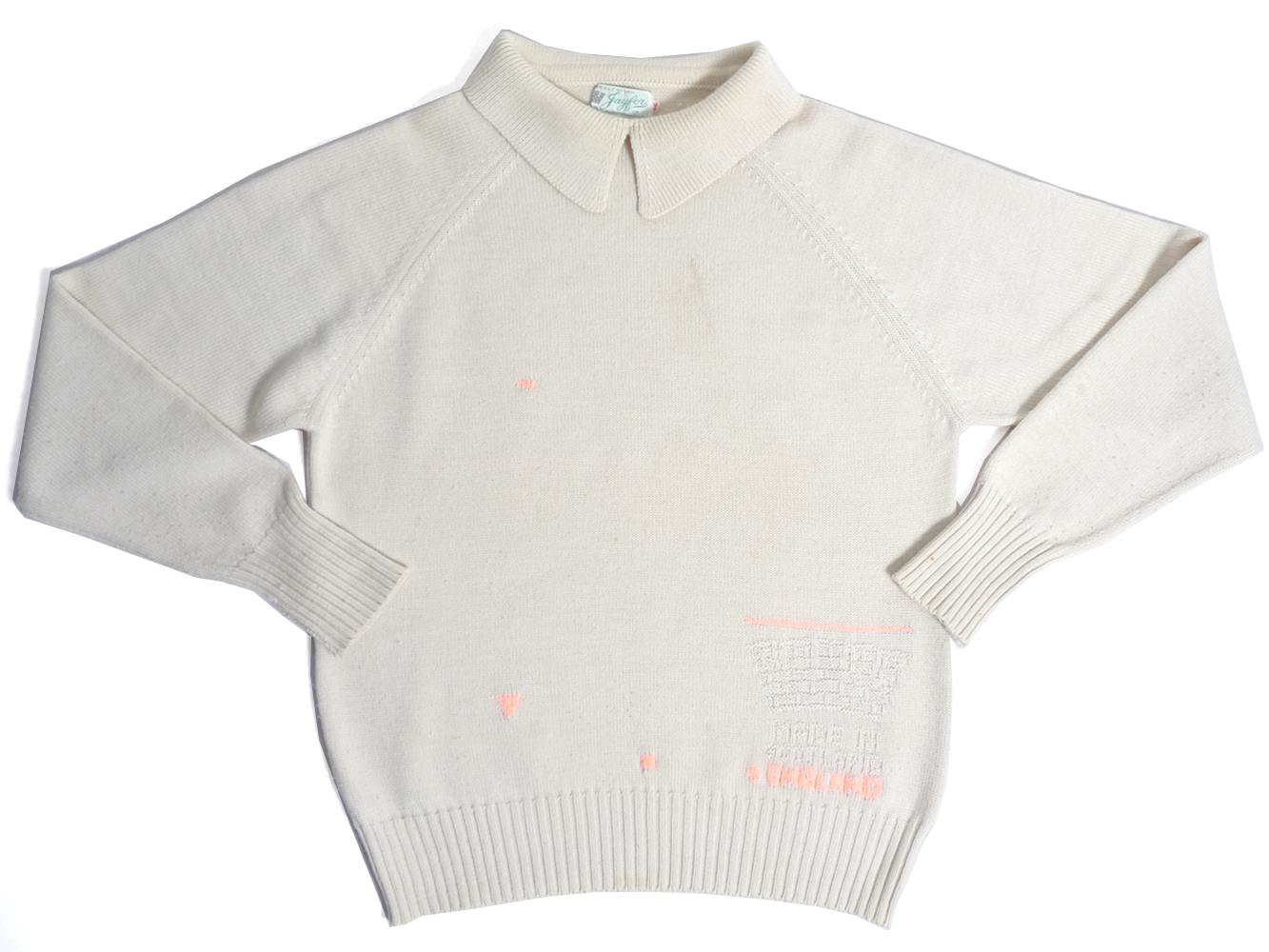

ATH + Jayfor
Found jumper, stitch-hacked and swiss darned
I took the text from the label of this old jumper - 'Jayfor of Auchtermuchty', 'made in Scotland' - and transposed it to the body of the garment, 'embossing' it into the structure of the plain knitting.
After the hacking, I used swiss darning (which embellishes, rather than restructures, the fabric) to record my part in its transformation. I added 'ATH +' to the Jayfor text, and '+ England' to 'made in Scotland'.
I love the font and placement of the Jayfor logo, which creates an incongruous reference to the Pink Ladies of Grease.
DISCUSSION OF STITCH-HACKING:
Knitting: Fashion, Industry, Craft by Sandy Black (V&A Publishing 2012)
Zen and the Abstract Machine of Knitting by Otto von Busch (Textile: Journal of Cloth and Culture, 2013)
Why it’s important to be open by Amy Twigger Holroyd (Crafts, 2014)
Knitting: Fashion, Industry, Craft by Sandy Black (V&A Publishing 2012)
Zen and the Abstract Machine of Knitting by Otto von Busch (Textile: Journal of Cloth and Culture, 2013)
Why it’s important to be open by Amy Twigger Holroyd (Crafts, 2014)
Cathedral Cardigans
The five reknitted cast-offs in this series interpret the construction details of gothic cathedrals in diverse ways. For me, these architectural icons share ornamental flourishes with traditional crochet and knitting. The buildings also offer great inspiration in terms of remaking, with physical breakdown and the whims of fashion having created patchworks of repair, rebuilding and extension.
Inspiration includes the blind tracery in Southwark Cathedral’s retrochoir; arcading at Southwell Minster; the window of Gloucester Cathedral; miniature towers and spires adorning the exterior of Lichfield Cathedral; and the flying buttresses of York Minster.
This series of work was included in the Units of Possibility exhibition, part of the Reknit Revolution project.
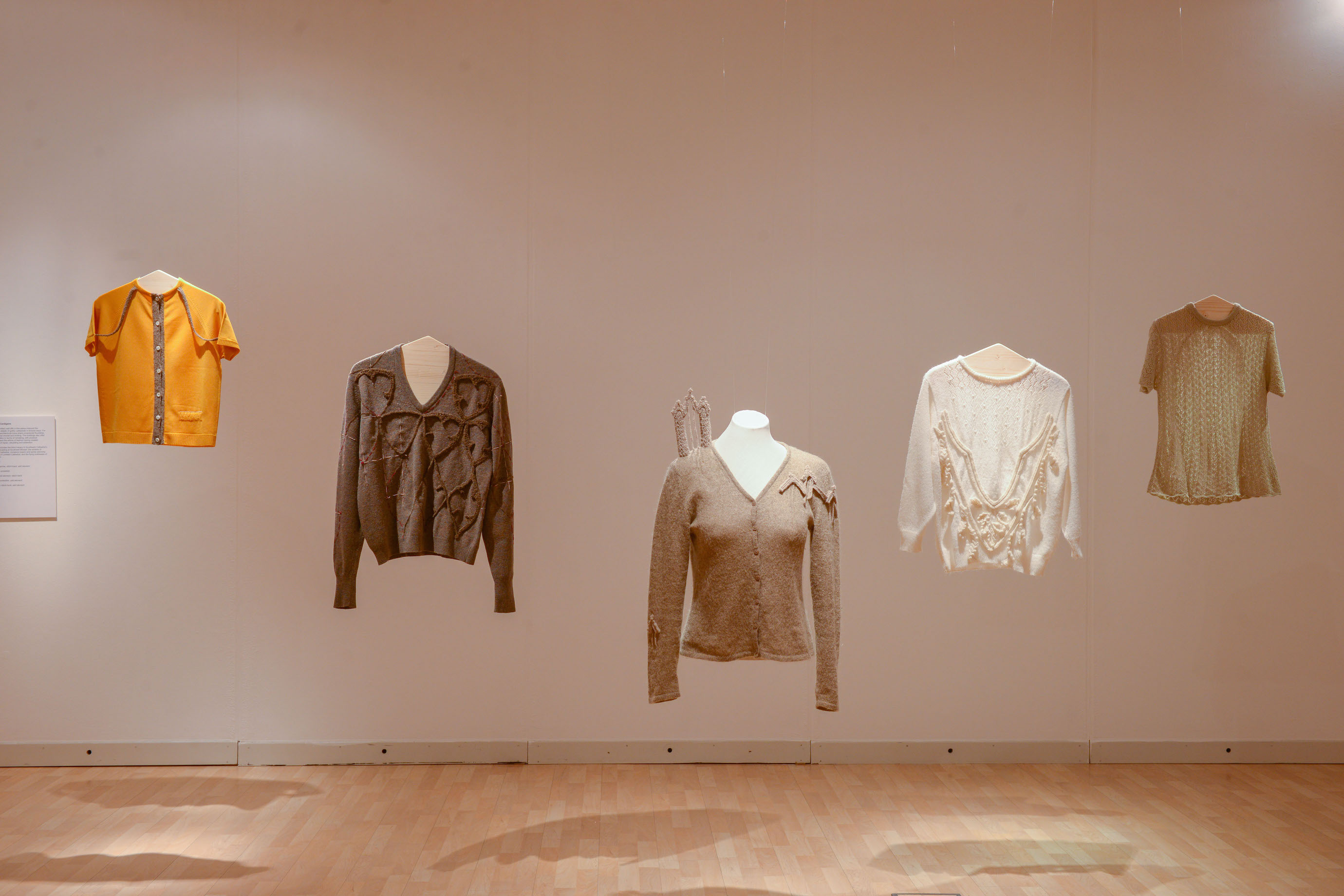


Top photograph by Jamie Grey at Rugby Art Gallery & Museum
Pattern-blagging
Pattern-blagging involves the modification of an existing knitting or crochet pattern to create a personalised item, inserting personal text to an otherwise standard design.
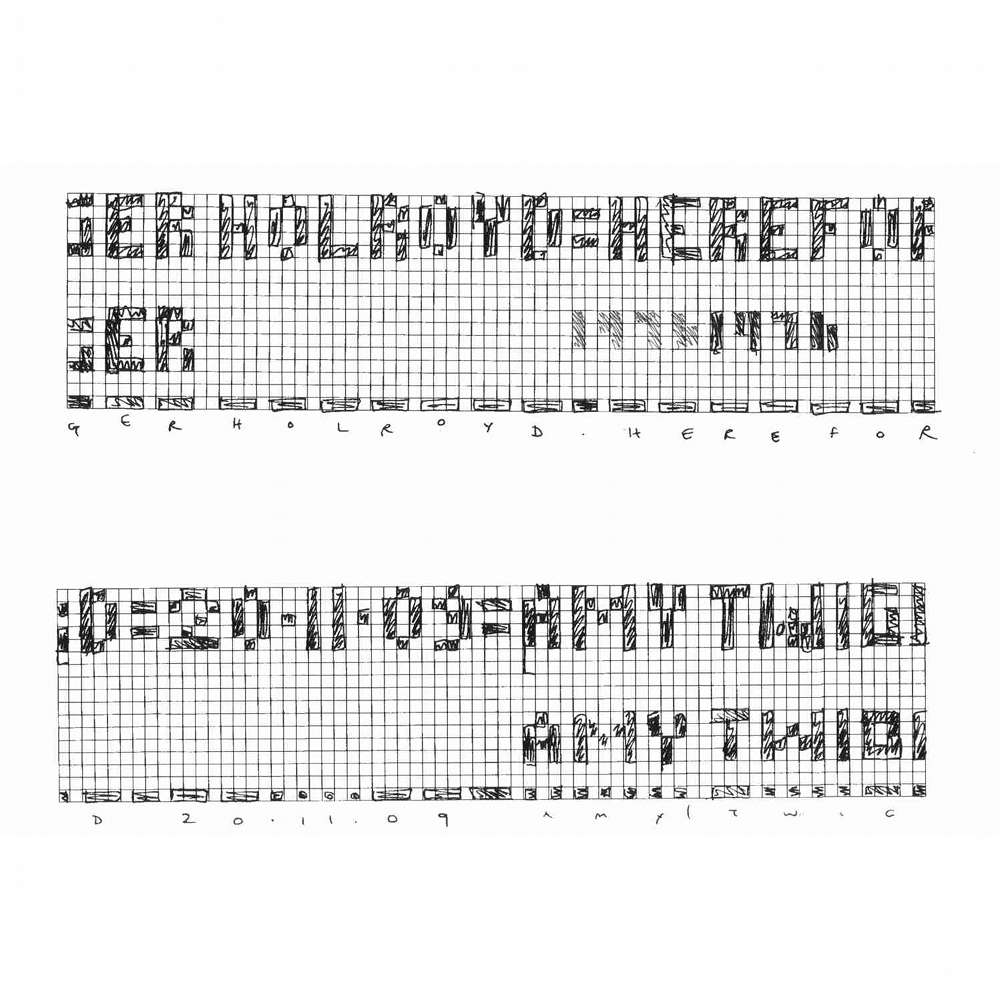
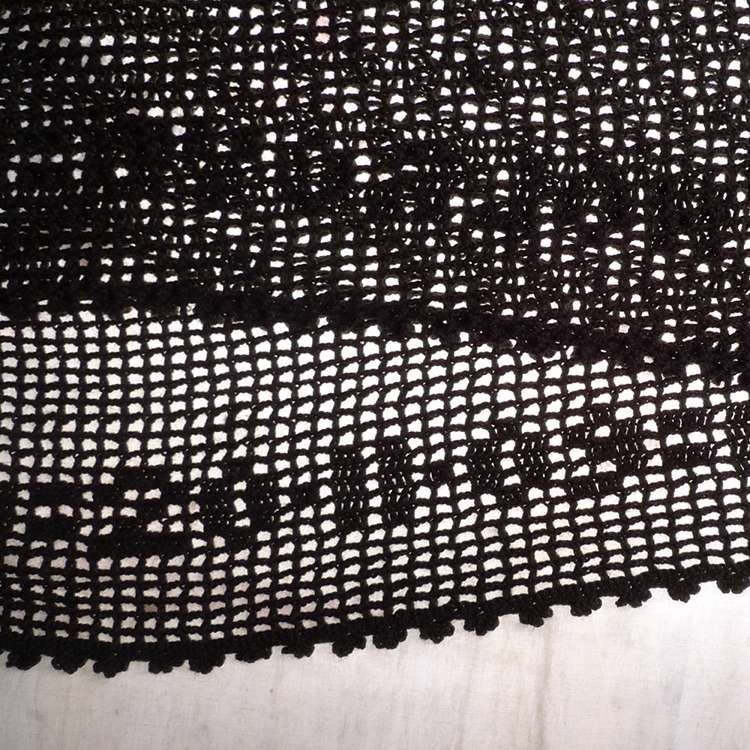
20.11.09 - 1976
Filet crochet smock, pattern-blagged
Original pattern published in ‘Knitting, Crochet & Embroidery’ in 1976.
My first pattern-blagged piece. I originally intended to make this piece ‘true to pattern’, but when I came to the first row of the original design (a floral border, created within the filet crochet structure), I rebelled.
The text around the hem reads 'Amy Twigger Holroyd - Hereford - 20.11.09'. '1976', the date the pattern was published, is worked into the right sleeve.
![]()
![]()
1.12.2010 - 1.10.2011
Shetland lace shawl, pattern-blagged
Original pattern ‘The Rosemary Shawl’ designed by Gema Ord for Jamieson & Smith, published in ‘My Weekly’ in 1994.
In September 2010, following my presentation on Stitch-Hacking and Pattern-Blagging at the ‘In The Loop 2’ knitting conference in Shetland, I boldly stated that I would pattern-blag a Shetland lace shawl. Twelve months later, I completed the challenge. My rules: the personal adaptations had to be decided upon during the making process, and constructed spontaneously without sampling.
The shawl is knitted in the round from the outside towards the centre. The text included in this piece shows the date I knitted the outer border (1.12.2010) and the date I finished (1.10.2011), along with the name of the village where I lived (Lugwardine), and 'Amy' repeated on each side.
Filet crochet smock, pattern-blagged
Original pattern published in ‘Knitting, Crochet & Embroidery’ in 1976.
My first pattern-blagged piece. I originally intended to make this piece ‘true to pattern’, but when I came to the first row of the original design (a floral border, created within the filet crochet structure), I rebelled.
The text around the hem reads 'Amy Twigger Holroyd - Hereford - 20.11.09'. '1976', the date the pattern was published, is worked into the right sleeve.
1.12.2010 - 1.10.2011
Shetland lace shawl, pattern-blagged
Original pattern ‘The Rosemary Shawl’ designed by Gema Ord for Jamieson & Smith, published in ‘My Weekly’ in 1994.
In September 2010, following my presentation on Stitch-Hacking and Pattern-Blagging at the ‘In The Loop 2’ knitting conference in Shetland, I boldly stated that I would pattern-blag a Shetland lace shawl. Twelve months later, I completed the challenge. My rules: the personal adaptations had to be decided upon during the making process, and constructed spontaneously without sampling.
The shawl is knitted in the round from the outside towards the centre. The text included in this piece shows the date I knitted the outer border (1.12.2010) and the date I finished (1.10.2011), along with the name of the village where I lived (Lugwardine), and 'Amy' repeated on each side.
Participatory projects
Around 2010–2012 I ran a series of participatory knitting projects in a range of contexts, in association with organisations including Craftspace, Lichfield Festival, BMW Plant Hams Hall and mac Birmingham.
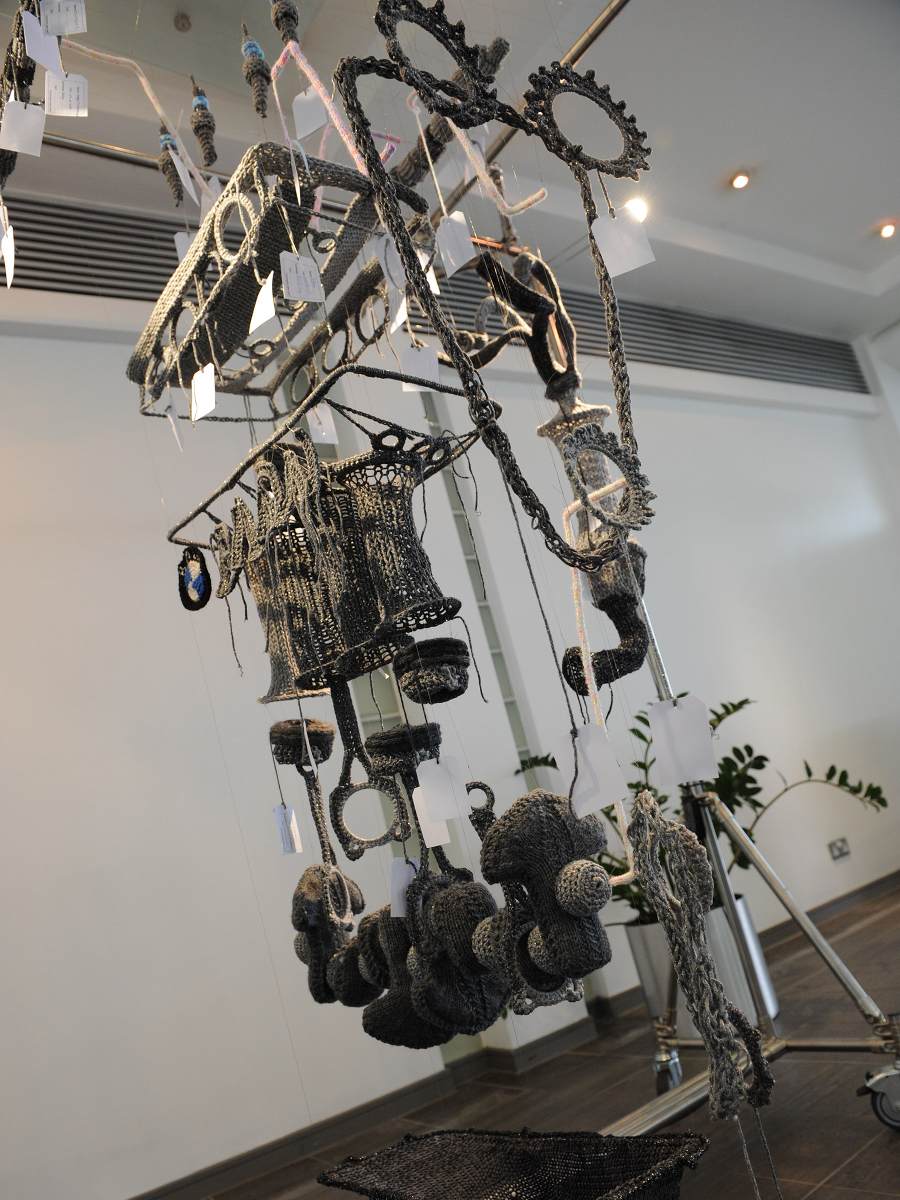

Keep & Share Knitting Tent
The Keep & Share Knitting Tent visited festivals around the UK each summer from 2009 to 2014. Tour dates included Latitude, Green Man, End of the Road, Hay Festival and Port Eliot.
A key element of the Knitting Tent was the participatory Knitting Circle. Festival-goers were invited to drop in and knit for a while, with volunteers on hand to teach those who wanted to learn. All of the contributions added onto a communal knitted web, which grew from event to event. Comments from participants, noted on small tags and reflecting on their experiences of knitting, provided valuable data for my PhD research.

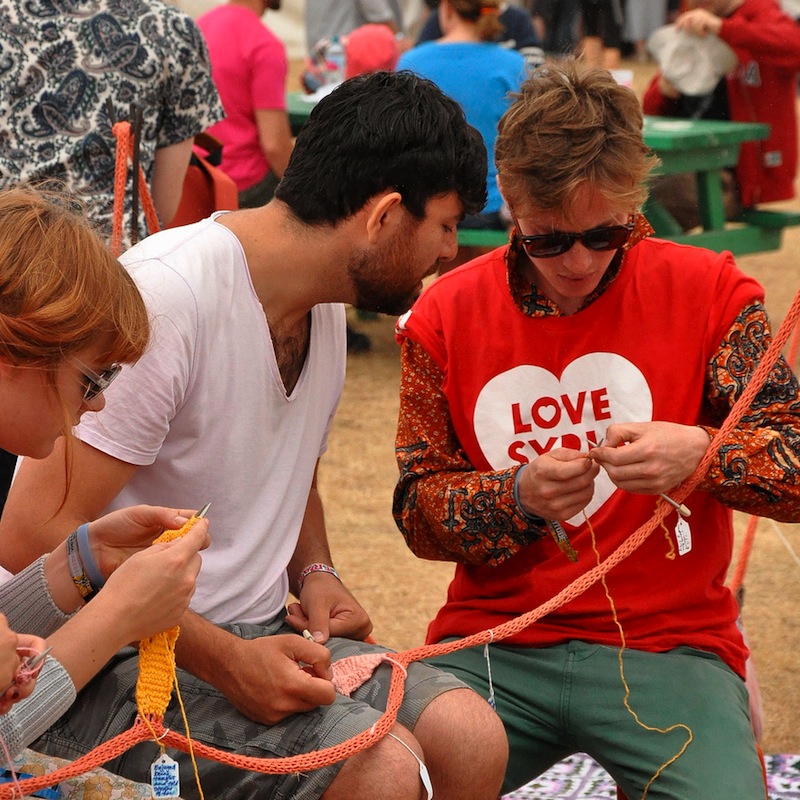
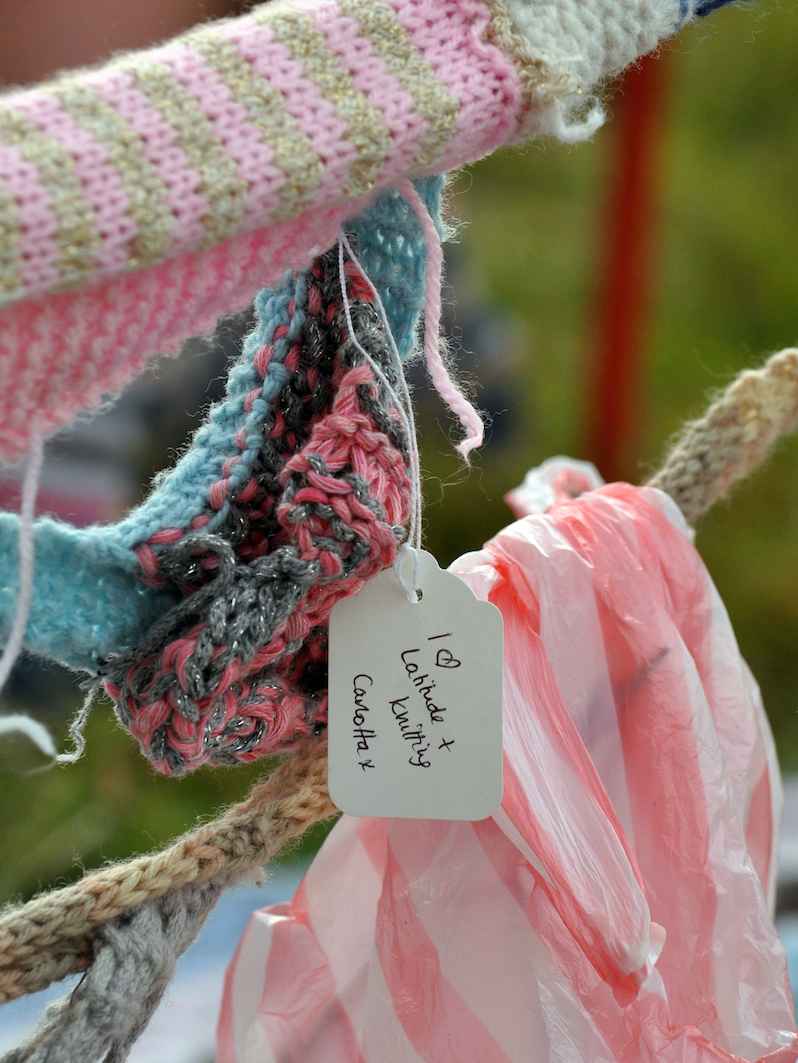
Photography by Amy Twigger Holroyd and Cybèle de Jong
Other projects
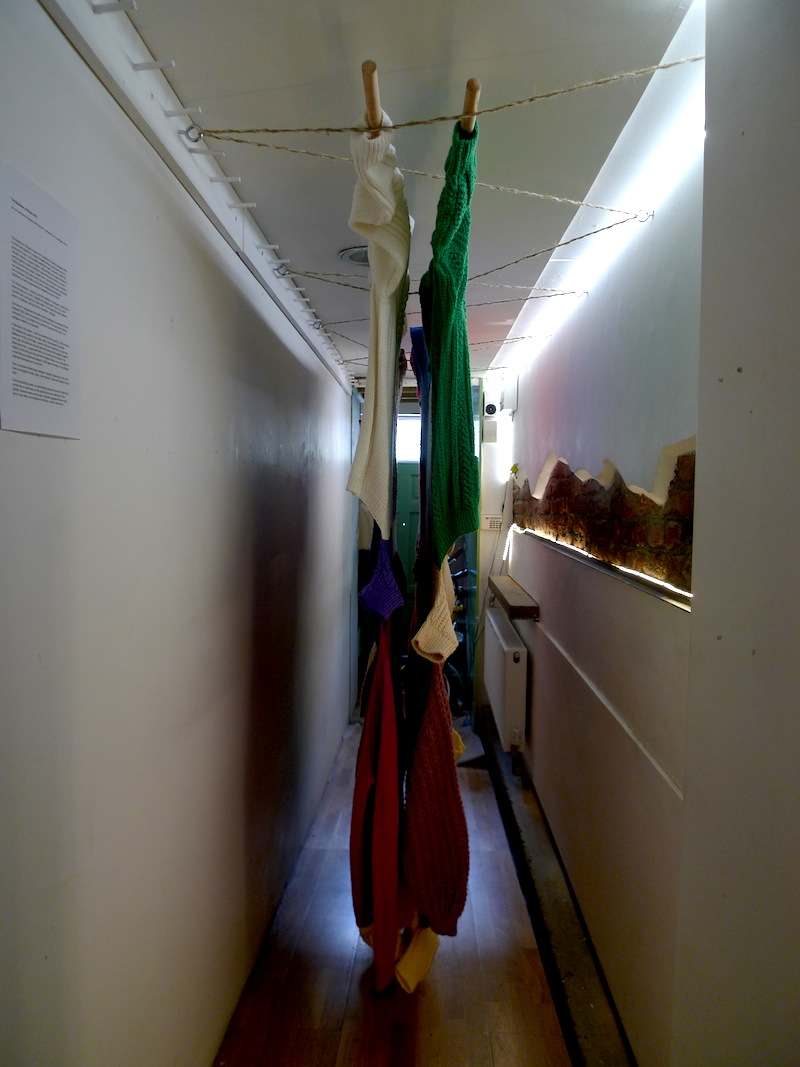

Backbone of Britain
The Backbone of Britain is made from a collection of twenty cardigans which was found stashed in a chest of drawers in my great aunt's house - hand knitted, seemingly unworn, all acrylic. We think my grandmother, Gladys, knitted them - but can't be sure, as she died a few years before they were found.
For obvious reasons, I ended up with this collection of cardigans. I didn't feel a desire to wear any of them, but didn't feel I could get rid of them either. In 2013, aided by Celia Pym and Rachael Matthews, I helped the cardigans to organise themselves into a new form.
The Backbone of Britain is made from a collection of twenty cardigans which was found stashed in a chest of drawers in my great aunt's house - hand knitted, seemingly unworn, all acrylic. We think my grandmother, Gladys, knitted them - but can't be sure, as she died a few years before they were found.
For obvious reasons, I ended up with this collection of cardigans. I didn't feel a desire to wear any of them, but didn't feel I could get rid of them either. In 2013, aided by Celia Pym and Rachael Matthews, I helped the cardigans to organise themselves into a new form.
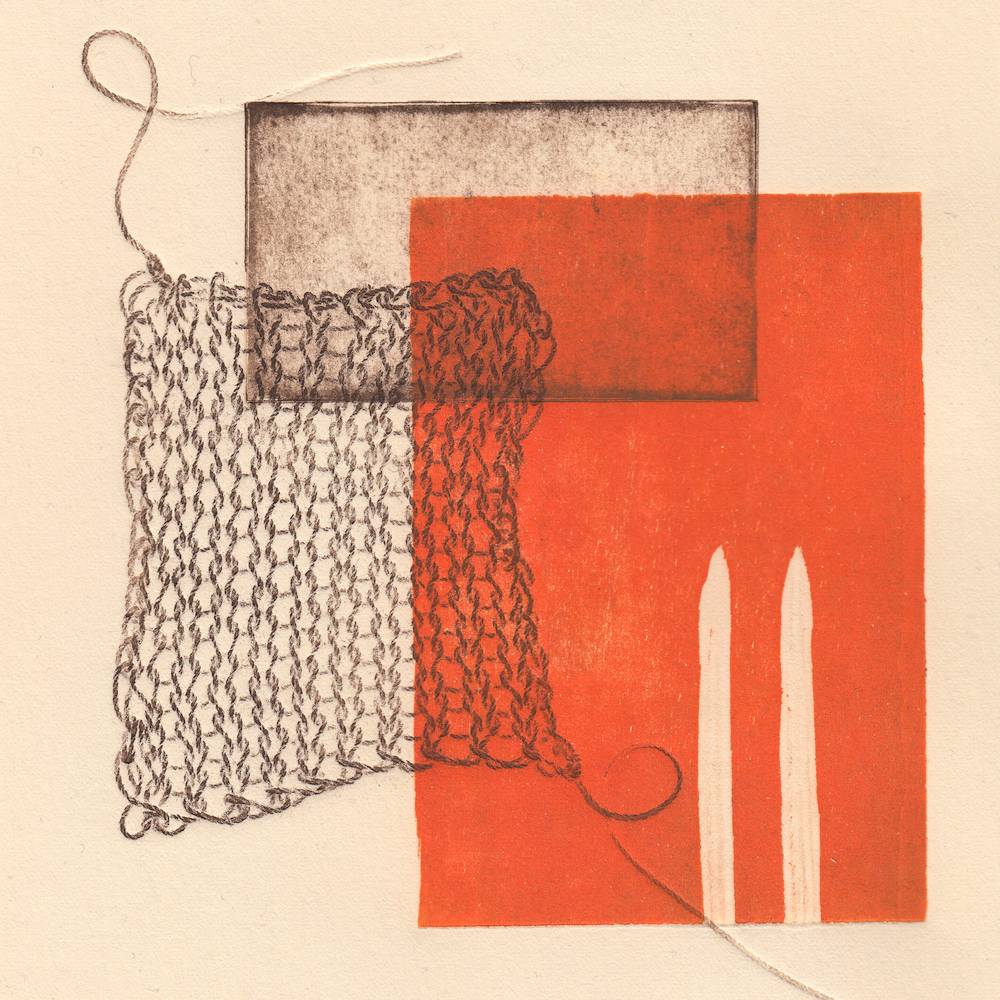
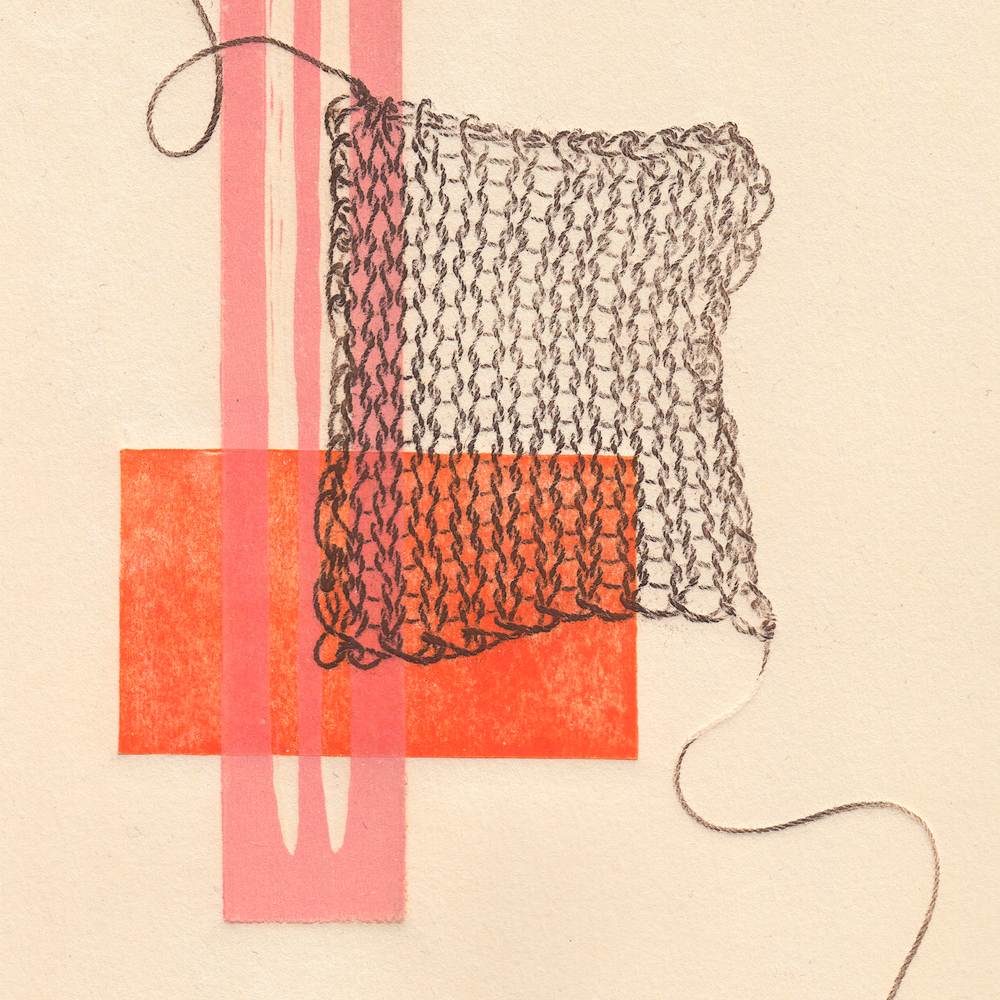


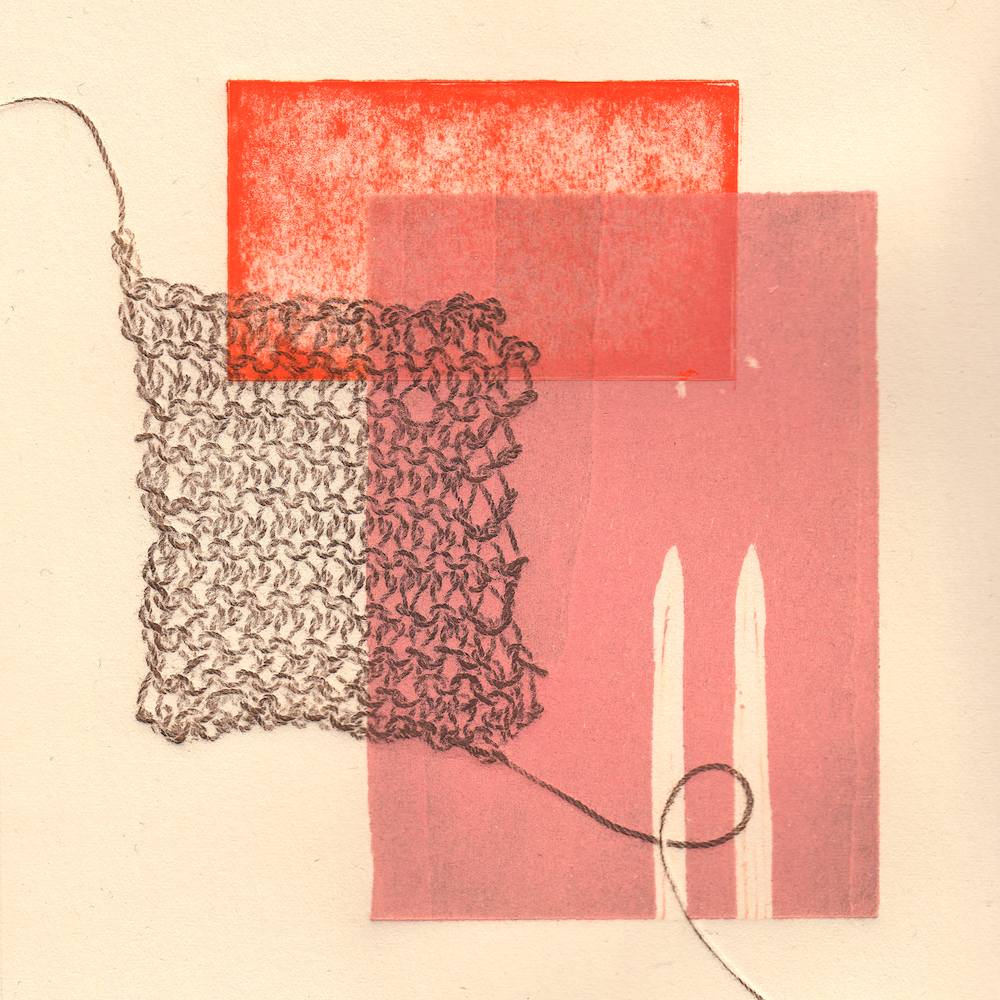
Needles and yarn #1-5
At a printmaking workshop, I discovered the collagraph technique and started to explore ways of printing with knitting. I find that these embossed monoprints show off the structure of the fabric, and perhaps make you look at knitting in a new light.
Needles and yarn #1 was used as promotional imagery for The Knitting & Stitching Show in 2017.
At a printmaking workshop, I discovered the collagraph technique and started to explore ways of printing with knitting. I find that these embossed monoprints show off the structure of the fabric, and perhaps make you look at knitting in a new light.
Needles and yarn #1 was used as promotional imagery for The Knitting & Stitching Show in 2017.